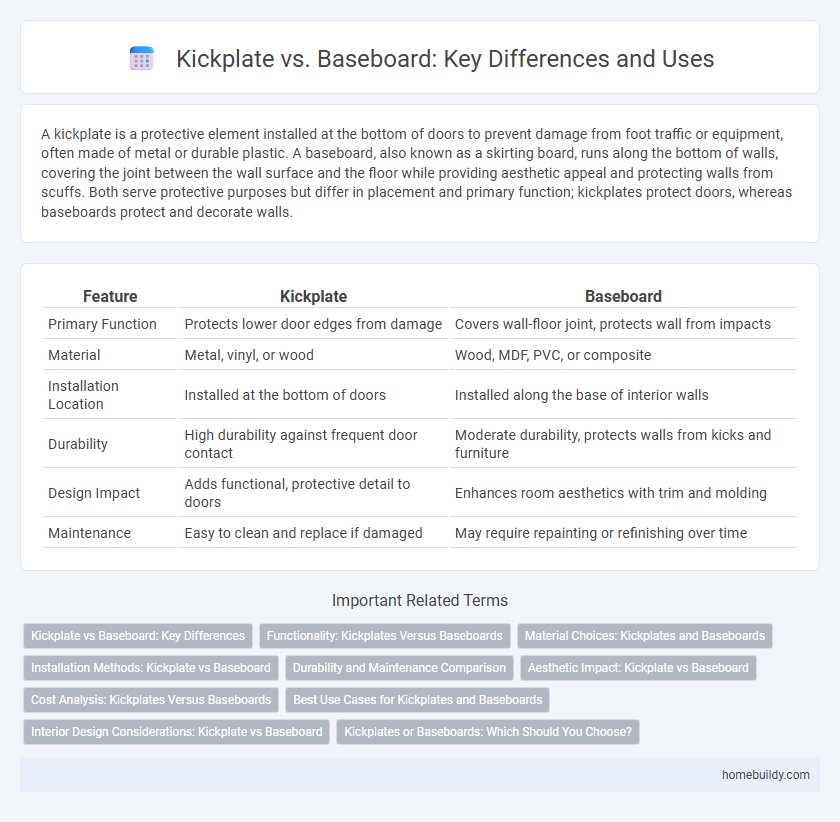A kickplate is a protective element installed at the bottom of doors to prevent damage from foot traffic or equipment, often made of metal or durable plastic. A baseboard, also known as a skirting board, runs along the bottom of walls, covering the joint between the wall surface and the floor while providing aesthetic appeal and protecting walls from scuffs. Both serve protective purposes but differ in placement and primary function; kickplates protect doors, whereas baseboards protect and decorate walls.
Table of Comparison
| Feature | Kickplate | Baseboard |
|---|---|---|
| Primary Function | Protects lower door edges from damage | Covers wall-floor joint, protects wall from impacts |
| Material | Metal, vinyl, or wood | Wood, MDF, PVC, or composite |
| Installation Location | Installed at the bottom of doors | Installed along the base of interior walls |
| Durability | High durability against frequent door contact | Moderate durability, protects walls from kicks and furniture |
| Design Impact | Adds functional, protective detail to doors | Enhances room aesthetics with trim and molding |
| Maintenance | Easy to clean and replace if damaged | May require repainting or refinishing over time |
Kickplate vs Baseboard: Key Differences
Kickplates are protective metal or plastic strips installed at the bottom of doors to prevent damage from foot traffic, while baseboards are decorative trim pieces that cover the joint between the wall and floor. Kickplates offer functional durability, ideal for high-traffic areas, whereas baseboards primarily enhance aesthetic appeal and provide wall protection from impacts and cleaning tools. The material choice for kickplates often includes stainless steel or brass, contrasting with baseboards typically made from wood or MDF for easy painting and design integration.
Functionality: Kickplates Versus Baseboards
Kickplates provide targeted protection for doors against scuffs and damage from foot traffic, making them essential in high-traffic areas. Baseboards serve as a protective barrier for walls against impacts and help conceal gaps between the wall and floor. While both enhance durability, kickplates specifically safeguard door surfaces, whereas baseboards focus on protecting and finishing wall edges.
Material Choices: Kickplates and Baseboards
Kickplates are typically crafted from durable materials like stainless steel, aluminum, or brass to resist impacts and enhance door protection, while baseboards commonly use wood, MDF, or PVC for aesthetic trim and wall protection. The metal composition of kickplates offers superior durability against dents and scratches, making them ideal for high-traffic areas, whereas baseboards prioritize design versatility and ease of painting or staining. Selecting materials depends on the balance between functional resistance needed on doors and the decorative appeal required along walls.
Installation Methods: Kickplate vs Baseboard
Kickplates are typically installed using adhesive backing or screws directly onto the lower part of the door or wall, offering a simple and quick application process. Baseboards require nailing or screwing into the wall studs and often involve caulking and painting for a finished look, making their installation more labor-intensive. The choice between kickplate and baseboard installation depends on the desired durability, aesthetic, and the skill level available for the project.
Durability and Maintenance Comparison
Kickplates offer superior durability compared to baseboards, as they are typically made from metal or heavy-duty materials designed to withstand frequent impacts and wear. In contrast, baseboards are often crafted from wood or MDF, which are more susceptible to dents, scratches, and moisture damage, requiring more frequent repairs or replacement. Maintenance of kickplates is minimal, usually limited to occasional cleaning, while baseboards demand regular repainting or refinishing to maintain their appearance and structural integrity.
Aesthetic Impact: Kickplate vs Baseboard
Kickplates provide a streamlined, modern aesthetic by offering clean protection at the bottom of doors, contrasting with baseboards that serve as decorative wall trims with more intricate designs. Unlike baseboards, which can visually break up wall space and add architectural detail, kickplates maintain door integrity without altering the room's overall style. The choice between kickplate and baseboard significantly influences the visual harmony and functional emphasis in interior design.
Cost Analysis: Kickplates Versus Baseboards
Kickplates generally offer a more cost-effective solution compared to baseboards due to lower material and installation expenses, especially in commercial settings where durability is prioritized. Baseboards, while often more aesthetically versatile, involve higher labor costs and materials such as wood or MDF, increasing the overall budget. Choosing kickplates can reduce maintenance costs over time as they provide focused protection against damage to doors and walls in high-traffic areas.
Best Use Cases for Kickplates and Baseboards
Kickplates are best suited for high-traffic areas where door protection from scuffs and impacts is essential, such as commercial buildings and kitchens. Baseboards excel in covering wall-floor joints while enhancing aesthetic appeal and are ideal for residential spaces requiring decorative finishes and moisture resistance. Selecting kickplates or baseboards depends on the need for durability and protection versus design and wall protection.
Interior Design Considerations: Kickplate vs Baseboard
Kickplates offer durable protection to doors in high-traffic areas while maintaining a sleek, modern aesthetic, making them ideal for contemporary interior designs. Baseboards provide a traditional look, covering the joint between wall and floor, and add architectural detail but are more vulnerable to scuffs and damage compared to metal or vinyl kickplates. Interior designers often choose kickplates for minimalistic and industrial interiors, whereas baseboards suit classic or transitional styles, balancing functionality and visual appeal effectively.
Kickplates or Baseboards: Which Should You Choose?
Kickplates provide durable protection for doors against scuffs and dents, offering an easy-to-clean surface often made of metal or plastic, ideal for high-traffic areas. Baseboards, installed along the bottom of walls, primarily protect drywall from damage while contributing to room aesthetics through various styles and materials like wood or MDF. Choose kickplates for door protection and baseboards for wall protection, balancing functionality and design based on your space's specific needs.
kickplate vs baseboard Infographic

 homebuildy.com
homebuildy.com